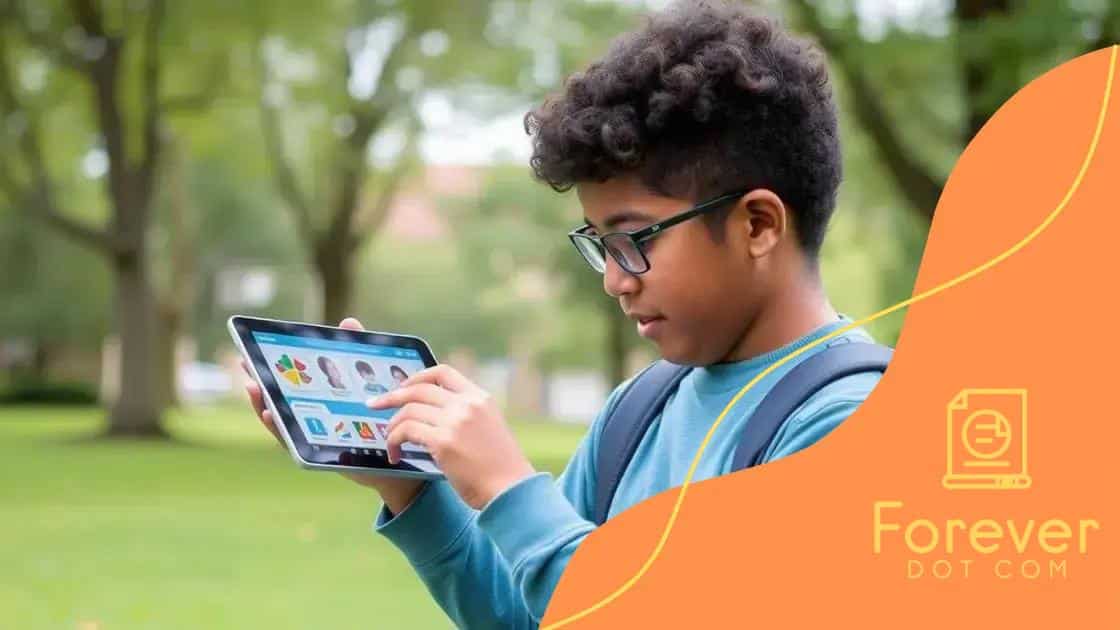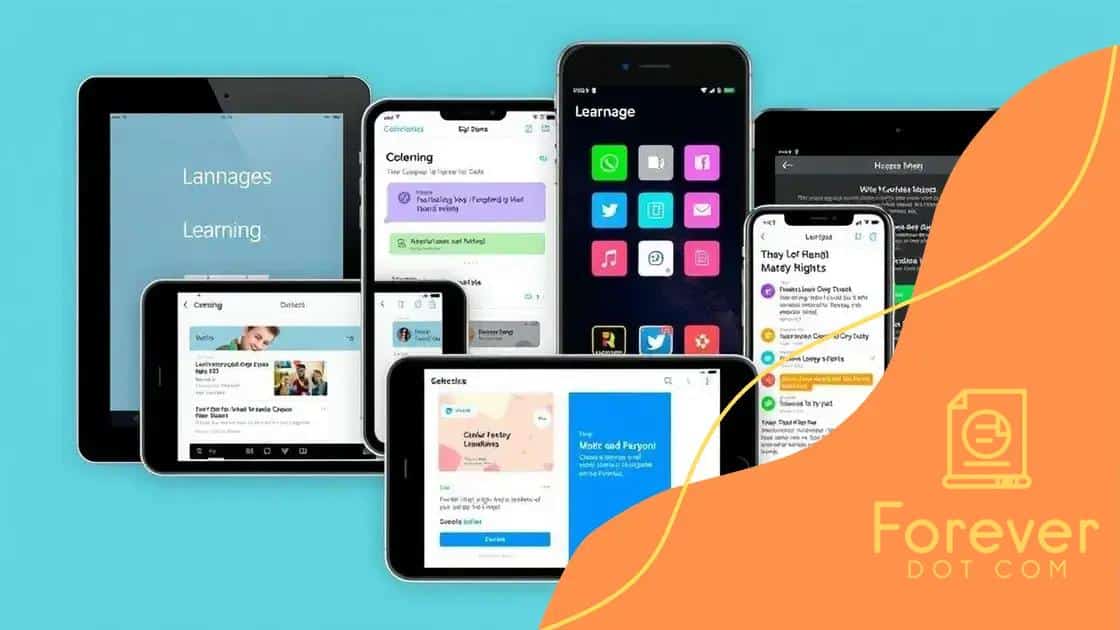Mobile apps as tools for extended learning beyond classrooms

Mobile apps as tools for extended learning enhance education by offering personalized experiences, interactive content through augmented reality, and collaborative platforms for students to engage and succeed in their learning journeys.
Mobile apps as tools for extended learning beyond classrooms are changing how we think about education. Ever considered how these tools can enhance learning experiences? In this post, we’ll explore the impact of mobile apps on education.
The role of mobile apps in education
The role of mobile apps in education is becoming increasingly important. These apps provide unique opportunities for students to learn in engaging and innovative ways. With the rise of technology, educational apps have transformed traditional teaching methods and opened new avenues for students to explore.
Types of Educational Mobile Apps
Many kinds of mobile apps cater to different learning needs and styles. Here are some popular categories:
- Learning platforms: Apps like Duolingo and Khan Academy offer structured courses on various subjects.
- Interactive tools: Apps such as Quizlet and Kahoot! allow students to engage through games and quizzes.
- Organization aids: Tools like Evernote help students keep track of their assignments and study materials.
- Subject-specific apps: Mathway and Photomath provide assistance in solving specific problems and understanding concepts.
These apps not only make learning more fun but also enhance retention. By introducing elements like gamification, they encourage students to participate actively in their education.
Benefits of Mobile Learning
Using mobile apps for learning comes with several key benefits. First, they promote flexibility. Students can learn anytime and anywhere, breaking the confines of traditional classrooms. This is especially helpful for students who may need additional practice outside school hours.
Additionally, these apps often provide personalized learning experiences. Many adapt to individual progress, allowing students to focus on areas where they need improvement. This tailored approach can significantly enhance overall learning outcomes.
Moreover, mobile apps foster collaboration. Many educational apps include features that allow students to work together, share knowledge, and support each other’s learning journeys.
In summary, the role of mobile apps in education cannot be overstated. They serve as powerful tools for engagement, collaboration, and personalized learning, paving the way for a brighter future in education.
Advantages of learning beyond the classroom
The advantages of learning beyond the classroom are vast and significant. By stepping outside traditional walls, students can engage with real-world experiences that enhance their educational journey. This type of learning fosters curiosity and encourages students to apply their knowledge in practical situations.
Enhanced Engagement
Learning beyond the classroom creates opportunities for enhanced engagement. When students participate in activities outside the classroom, they often feel more motivated. Experiences such as field trips or community projects allow them to connect what they learn in the classroom to the world around them.
- Real-world experiences: Exposure to real-life scenarios helps students grasp complex concepts.
- Active participation: Engaging in hands-on activities keeps students focused and interested.
- Social interaction: Collaborating with peers fosters teamwork and communication skills.
This active participation not only makes learning enjoyable but also reinforces the material in a memorable way. Furthermore, students can explore their interests deeply, leading to a more personalized approach to education.
Developing Critical Skills
Learning beyond the classroom also aids in developing essential skills. Students must often adapt to new environments and challenges, which promotes critical thinking and problem-solving abilities. They learn to navigate different situations and enhance their decision-making skills.
Moreover, this type of learning cultivates independence. As students engage in activities that require them to think creatively and take initiative, they become more self-sufficient. These skills are invaluable not only in academics but also in their future careers.
Learning outside the classroom also broadens students’ horizons. They get the chance to explore diverse cultures and ideas, which helps foster inclusivity and appreciation for different perspectives. Understanding these differences is crucial in today’s global society.
Overall, the advantages of learning beyond the classroom are clear. It promotes engagement, critical skill development, and a broader worldview, making education more relevant and impactful for students.
Types of mobile apps for extended learning

Understanding the types of mobile apps for extended learning is key to maximizing educational opportunities. These apps cater to various learning needs and styles, offering unique ways to enhance knowledge and skills. With so many options available, students can find the perfect fit for their learning preferences.
Learning Management Systems (LMS)
Learning Management Systems are essential tools for both students and educators. They provide a structured approach to education, allowing users to manage courses, track progress, and interact with peers. Popular examples include:
- Moodle: An open-source platform that supports various activities like quizzes and forums.
- Canvas: Known for its user-friendly interface and integration with other educational tools.
- Google Classroom: A widely-used tool that helps teachers organize and streamline assignment management.
These apps make it easier for students to access course materials and receive feedback from instructors, creating a collaborative learning environment.
Language Learning Apps
Language learning apps have gained immense popularity due to their convenience and accessibility. With interactive exercises and games, they make acquiring a new language fun and engaging. Notable language learning apps include:
- Duolingo: Uses gamification techniques to motivate users and track their progress.
- Babbel: Focuses on conversation skills and real-life dialogues for practical learning.
- Rosetta Stone: Emphasizes immersive language learning through visual and auditory cues.
These apps enable learners to practice at their own pace, making it easier to incorporate language study into their daily routines.
Content Creation and Study Tools
Content creation apps help students organize their ideas and study materials effectively. They allow for creativity in how students present their knowledge. Some examples include:
- Evernote: A note-taking app that helps organize thoughts, research, and tasks.
- Microsoft OneNote: Offers a flexible workspace to gather and manage notes, drawings, and lists.
- Quizlet: Enables students to create flashcards and quizzes for self-study.
These tools not only enhance understanding but also make studying more interactive and enjoyable.
With these diverse types of mobile apps for extended learning, students can explore different ways to enhance their educational experiences. By choosing the right apps, they can engage deeply with the material and improve their overall academic performance.
Best practices for using mobile apps in education
Using mobile apps in education effectively requires understanding some best practices. These guidelines help maximize the benefits of technology while ensuring a positive learning experience. By implementing these strategies, educators and students can enhance their educational outcomes.
Selecting the Right Apps
The first step is to select apps that align with learning objectives. Evaluating the app’s features is crucial. Look for apps that:
- Enhance engagement: Choose apps that motivate students and encourage active participation.
- Support various learning styles: Select apps that cater to visual, auditory, and kinesthetic learners.
- Provide measurable outcomes: Look for tools that offer tracking and assessment features for progress monitoring.
By choosing the right apps, educators empower students to learn in ways that resonate with them.
Integrating Apps Into the Curriculum
Integration of apps should be seamless within the curriculum. Establish clear goals for app usage in learning activities. For instance, apps can be introduced during:
- Direct instruction: Use apps to provide additional resources or interactive lessons.
- Independent practice: Encourage students to use apps for homework assignments and practice.
- Collaboration: Utilize apps for group projects and discussions.
This structured approach ensures that apps complement traditional teaching methods rather than replace them.
Another important aspect is ensuring students receive proper training on how to use these mobile tools. Teaching them to navigate the apps effectively increases their confidence and enhances learning potential. Regular check-ins and feedback help keep students on track and encourage their engagement.
Encouraging Responsible Use
Promoting responsible use of mobile apps is essential in educational settings. Set clear expectations regarding app usage policies, including:
- Time management: Encourage students to limit their screen time and balance app usage with other activities.
- Content guidelines: Teach students to evaluate resources critically to avoid misinformation.
- Privacy awareness: Discuss the importance of protecting personal information when using apps.
Establishing these guidelines fosters a safe and productive learning environment for all students.
Incorporating feedback loops where students can share their experiences with apps also allows for continuous improvement in app usage strategies. This collaborative approach creates a sense of ownership among students and helps educators refine their methods.
Future trends in mobile learning
The future trends in mobile learning show exciting possibilities for education. As technology continues to evolve, these trends will reshape how students engage with educational content. Keeping an eye on these trends can help educators and students prepare for what’s ahead.
Increased Personalization
One major trend is the move toward increased personalization in learning experiences. Mobile apps will continually adapt to meet individual learning styles and preferences. This tailored approach ensures that each student can progress at their own pace. Features that utilize artificial intelligence (AI) will analyze a student’s performance and adjust the content accordingly.
- Customized Learning Paths: Students can choose paths that align with their interests and strengths.
- Adaptive Assessments: Tests that adjust difficulty based on student responses provide accurate skill evaluations.
- Real-Time Feedback: Immediate responses will allow students to understand mistakes and correct them on the spot.
This level of customization will make learning more engaging and effective for everyone.
Increased Use of Augmented Reality (AR)
Another exciting trend is the integration of augmented reality in mobile learning. AR technology can create immersive educational experiences that bring abstract concepts to life. For instance, students can explore the solar system by virtually interacting with planets and stars right in their classrooms.
AR can enhance learning in various subjects:
- Science: Students conduct virtual experiments in a safe environment.
- History: Interactive timelines allow students to experience historical events dynamically.
- Arts: Students can visualize art techniques using AR overlays.
This kind of engagement not only boosts learning but also inspires curiosity in students.
Collaborative Learning Environments
Future mobile learning will also emphasize collaboration. As remote learning continues to be prevalent, mobile apps will provide opportunities for students to collaborate with peers around the world. Tools and platforms designed for teamwork will create a sense of community and connectivity among learners.
These collaborative tools will include features such as:
- Discussion Boards: Students can engage in conversations about subjects they are learning.
- Group Projects: Collaborative projects will promote teamwork skills among students.
- Virtual Classrooms: Lively class sessions will allow students to participate actively regardless of their physical location.
Such interactions prepare students for future workplaces, which increasingly rely on teamwork and communication.
In summary, the future of mobile learning holds immense potential. With trends like personalization, augmented reality, and collaborative environments, students can expect enriched educational experiences that empower them for success.
FAQ – Frequently Asked Questions about Mobile Learning
What are the main advantages of mobile learning?
Mobile learning allows for flexibility, personalized experiences, and access to resources anytime and anywhere.
How can augmented reality be used in education?
Augmented reality in education can create interactive experiences, such as virtual field trips, enhancing student engagement.
What types of apps are best for extended learning?
Best apps include learning management systems, language learning apps, and content creation tools that cater to diverse learning styles.
How do educators integrate mobile apps into their teaching?
Educators can integrate apps by aligning them with learning objectives and utilizing them during direct instruction, practice, and collaboration.






